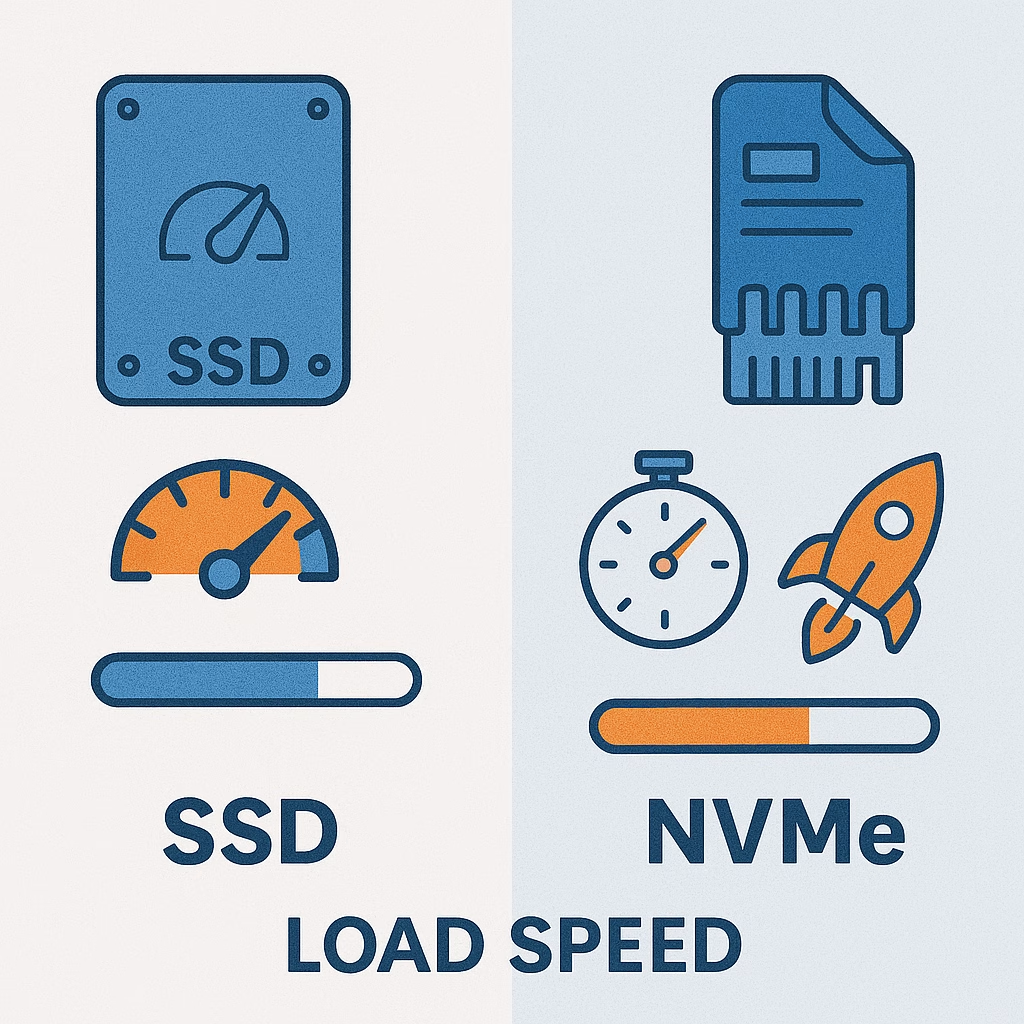
When you choose a web hosting For your business, one of the key aspects to consider is the type of storage used on the server. Disk drives SSD (Solid State Drive) have been a popular choice for many years due to their speed and reliability compared to traditional hard disk drives (HDD). However, with the evolution of technology, hard disk drives have become more and more NVMe (Non-Volatile Memory Express) have arrived to offer even higher speeds.
In this article, we will explore the main differences on SSD y NVMetwo storage technologies that are revolutionizing the world of web hosting. We will see what advantages each one offers and which is the best option depending on the needs of your business.
If you are just starting to learn about these technologies, we also recommend you to read SSD vs HDD Hosting: The Differences to understand the concepts from their basis.
Table of Contents
What is SSD storage and how does it work?
Definition: The disks SSD use flash memory to store data, which eliminates the moving parts of traditional hard disk drives (HDDs). This technology enables SSDs to offer much faster read and write speeds.
Advantages of SSDSSDs are faster, more durable and more energy efficient. This makes them ideal for web hostingThe new technology allows for faster loading times, better performance and greater reliability.
ExampleIf your website relies on loading dynamic content or handling high volumes of traffic, a SSD ensures that visitors enjoy a unique experience smooth and fast experience.
What is NVMe storage and how does it work?
Definition: The disks NVMe are a more advanced storage technology that utilizes the PCIe protocol (Peripheral Component Interconnect Express) to access data. While traditional SSDs use the SATA (Serial Advanced Technology Attachment) protocol, NVMe SSDs use a faster connection that communicates directly with the processor, offering much higher transfer speeds.
Advantages of NVMe: The disks NVMe are significantly faster than conventional SSDs, offering read and write speeds much higher, which further improves the performance of servers and websites.
ExampleIf your website has a high demand for data o performs many read/write intensive operations, such as complex databases or real-time applications, NVMe will be the best option.
Comparison between SSD and NVMe:
| Feature | SSD (SATA) | NVMe (PCIe) |
|---|---|---|
| Reading speed | Up to 550 MB/s | Up to 3500 MB/s |
| Writing speed | Up to 520 MB/s | Up to 3000 MB/s |
| Connection | SATA (slower protocol) | PCIe (faster connection) |
| Recommended use | Small to medium sized websites, eCommerce stores with moderate traffic. | Web sites with high traffic, large databases, or web applications that require extreme speed. |
| Cost | More economical | More expensive due to higher performance |
| Ideal applications | Information sites, blogs, small online stores. | Large eCommerce platforms, sites with very high traffic, real-time applications. |
Read and write speedsAs shown in the table, the discs NVMe are much faster than the SSD traditional. The read and write speeds of NVMe can be up to 7 times fasterwhich means that your website will load significantly faster.
ConnectionThe NVMe use the PCIe protocolwhich connects directly to the processor and provides a much higher bandwidth that the disks SATA SSDwhich have speed limitations due to their older protocol.
CostAlthough the NVMe offer superior performance, they are also more expensive than the SSD traditional. While the SSD are more than sufficient for many web sites, the NVMe are ideal for those who require extreme performance.
When to choose SSD and when to choose NVMe for your web hosting?
Choose SSD if:
Your website has moderate traffic.
You don't do a lot of write or read operations intensive.
You are looking for a cheaper option without compromising performance.
Choose NVMe if:
Your website receives high traffic or you have an online store with many transactions.
You need fast database operations or execute real-time applications.
You are willing to invest in the best possible performance, because NVMe can significantly improve speed and user experience.
Why choose ClickPanda's SSD or NVMe storage:
Superior performanceBoth the SSD hosting as the NVMe hosting from ClickPanda offer a exceptional performance. If you are looking for speed and efficiency, our plans provide you with the best of both technologies.
ScalabilityThe plans of ClickPanda are tailored to your needs, whether you are starting out with a small website or managing a high-traffic platform that requires NVMe to maximize performance.
24/7 support: With ClickPandaIf you need technical support, you will have specialized technical support available 24 hours a day to help you manage your server and ensure that your site is always optimized.
Success story:
Case Study 1: SSD storage in an online clothing store
Context:
A fast-growing online clothing retailer decided to improve the shopping experience on its website due to user complaints about slow load times, especially during promotions and flash sales. The site was using a storage-based HDD that it could not handle the increased traffic during these periods.
Solution:
The store migrated its server to SSD storage to improve loading speed. The decision was based on the need to improve site response time and optimize the customer experience during traffic peaks.
Results:
30% reduction in loading timesWebsite load times were reduced by 30%, which resulted in a significant improvement in user experience.
Increased conversionsWith faster loading, the conversion rate increased by 15% during flash sales, as users did not abandon the cart due to the wait.
Increased customer satisfaction: The store received positive feedback on the speed of the site and the checkout process was smoother, which increased the customer loyalty.
Case Study 2: NVMe Storage in a Real-Time Data Analytics Platform
Context:
A global data analytics company, working with large volumes of real-time information, was using SSD storage on their servers to process and analyze customer data. However, as the complexity of the analysis and volume of data increased, they began to experience bottlenecks during the real-time data write and read processes, affecting the speed at which they generated reports and analysis for their clients.
Solution:
The company decided to migrate to NVMe storage to more efficiently handle the processing of large volumes of real-time data. NVMe offered them a significantly higher data transfer rate compared to traditional SSDs, especially useful for your applications that require instant access to large amounts of data.
Results:
50% reduction in processing timesThe time required to process and analyze large volumes of data was reduced by half, improving operational efficiency.
Improved customer experienceReports and analysis were generated much more quickly, allowing the company to provide real-time results to its customers, improving its competitiveness.
Increased scalabilityThe ability to handle large amounts of data simultaneously without impacting performance allowed the company to scale its infrastructure smoothly, facilitating its expansion into new markets.
These examples highlight how the SSD storage is ideal for websites with moderate traffic that require fast loading times and a improved user experiencewhile NVMe is perfect for more advanced applications, such as processing large volumes of data in real time, which require exceptional speed to keep the operating efficiency and the competitiveness.
Ready to improve the speed and performance of your website? ClickPanda offers you SSD hosting y NVMe so you can choose the option that best suits your business needs.
Conclusion:
The SSD storage y NVMe offer significant advantages for improving speed y performance of your website. While both types of storage are fast, NVMe is the superior choice for high traffic and applications that require extremely fast loading times. At ClickPandawe offer hosting options SSD y NVMe tailored to your business needs, with constant technical support to make sure your website is always optimized.








